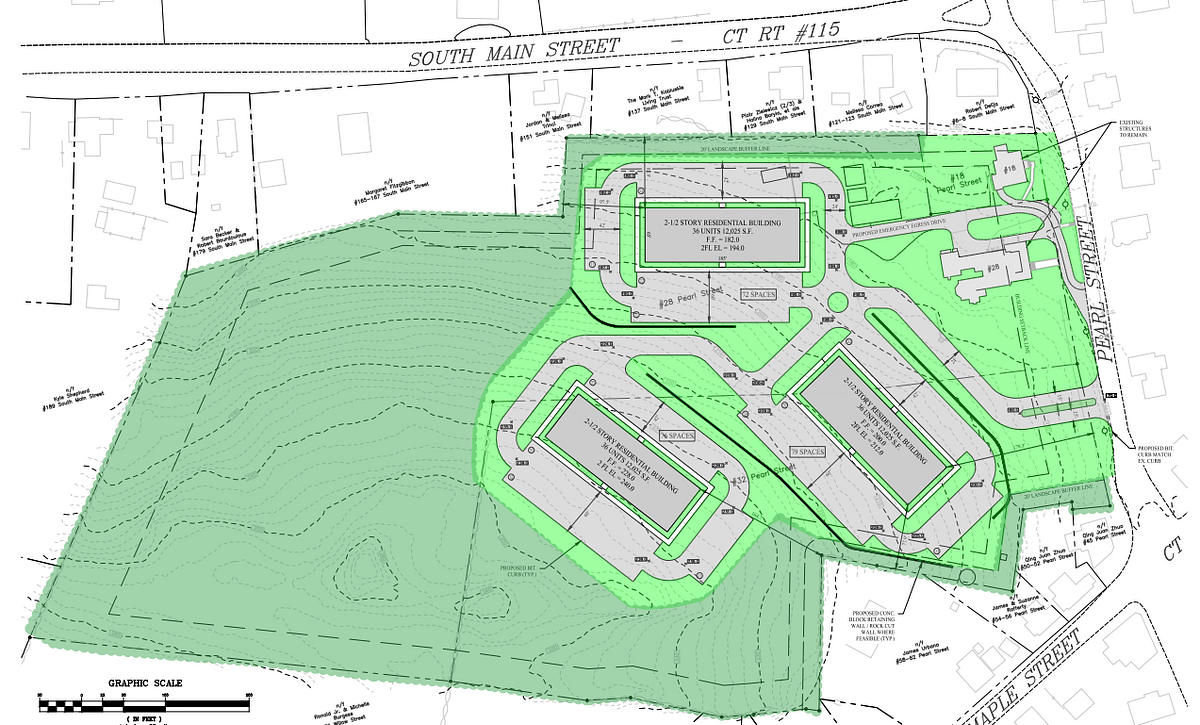
An image showing the land that is being requested for a zone change in Seymour.
SEYMOUR — A previously denied zone change to switch three residential properties on Pearl Street to multi-family housing is in front of the Seymour Planning and Zoning Commission again.
The commission held a public hearing Feb. 8 on a proposal by Second Street Construction, LLC for the zone change request. The developer wants property he owns at 18, 28 and 32 Pearl streets rezoned from R‑18, residential, to MF, multi-family.
The hearing is scheduled to continue at 6:15 p.m. March 14 at Seymour Town Hall.
The three properties border each other and comprise 14.6 acres of land.
According to town land records, the 28 Pearl St. address currently houses the Roberta King Estate, a circa-1900 brick mansion previously owned by the late Roberta King, a former Seymour Selectwoman and philanthropist. The property at 18 Pearl St. houses a Cape-style home built in 1745 and the property at 32 Pearl St. is vacant land.
Second Street Construction purchased the three properties for $1.3 million in 2018, according to town land records. The properties are surrounded by a mix of single-family and multi-family homes, along with a nearby corner deli, Thai restaurant, barber shop and an apartment complex at the former LoPresti School site.
This is the second time the same zone change request has come before the commission. The commission, last August, denied the zone change in a 2 – 1 vote, citing traffic concerns, financial considerations of the neighbors, and the location.
Attorney Dominick Thomas, of Derby, representing the developer, appealed the decision in Milford Superior Court, saying there was no evidence to support any issues with traffic, location or neighbors’ concerns about property values.
The appeal is still pending in court.
When the commission denied the zone change last August, Thomas said there were only three members present, including an alternate filling in for a regular member.
“The applicant is coming forward again because there are new members and is hoping to appeal to a full board,” said commission chairman Rob VanEgghen, who voted in favor of the original zone change request.
Town planner Keith Rosenfeld recommended the zone change be approved last August, citing the town’s Plan of Conservation and Development.
A multi-family site plan would require approval by special permit.
Thomas said the property can currently hold about 25 single-family homes. A conceptual site plan for the property, if changed to multi-family, could pave the way for 108 apartments, according to Thomas.
However, there is no site plan in front of the commission. Granting the zone change would pave the way for a detailed site plan application.
A conceptual site plan, Thomas said, would feature construction of three two-and-a-half story apartment buildings, each housing 36 apartments. The buildings would each comprise 12,025 square-feet and have 72 – 79 parking spaces each.
Thomas, at the Feb. 8 hearing, told the commission that apartments would be more beneficial to the town as opposed to single-family homes, because they “don’t generate a lot of kids” to impact the town schools. Approval by special permit would allow the commission to limit the number of bedrooms in a high-density complex.
Thomas said high-density residential housing generates economic development and benefits the town’s tax base. He said five out of nearby Shelton’s 10 largest taxpayers are high-density residential projects.
While multi-family housing results in more units, Thomas said multi-family preserves more open space on the land than a full build out of single-family houses.
Thomas said the existing mansion at 28 Pearl St. and the house at 18 Pearl St. would remain.
“This would be a high-density project with a lot of open space,” Thomas said. “This would most likely increase property values, not decrease them.”
About six residents spoke in opposition to the zone change at the Feb. 8 hearing, according to meeting minutes.
They cited concerns about increasing traffic on an already heavily traveled road. Pearl St. is narrow, neighbors said, and would not be able to accommodate the traffic the apartments would bring. They also cited dangerous nearby intersections where Pearl Street intersects Maple Street and South Main Street, and that the project will only be accessible through Pearl Street.